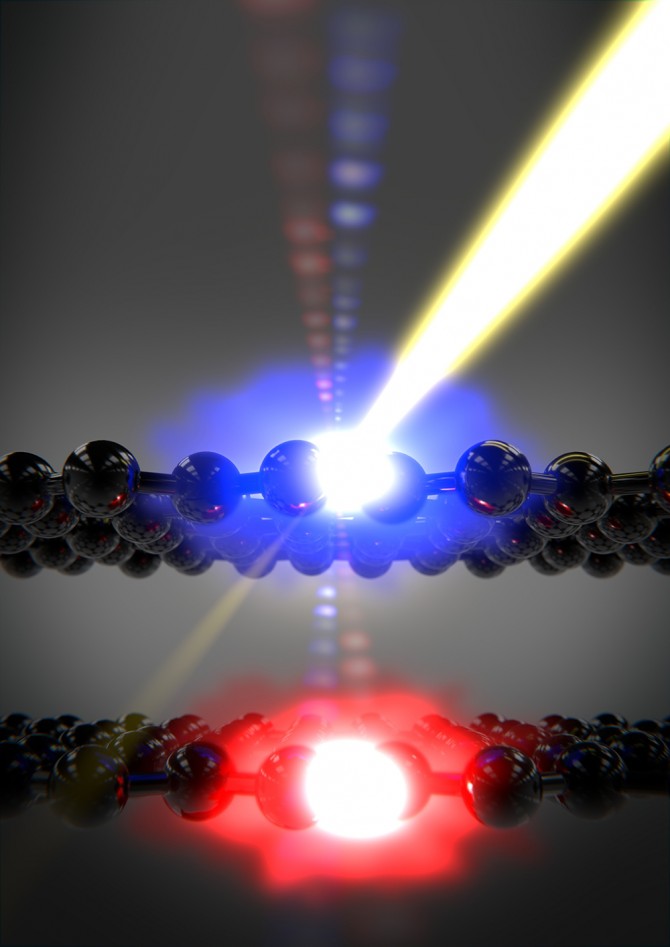Cornell collaboration reports unique property of bilayer graphene
By Tom Fleischman
Imagine walking through the Northwest wilderness, camera phone at the ready, hoping to catch at least a faint glimpse of Bigfoot, and instead returning home with an Ansel Adams-quality picture of the mythical beast as he lumbers past you.
That’s kind of what a team led by physics professor Paul McEuen has done in research into the optical properties of single-atom-thick layers of graphene.
Combining the technical strengths of two Kavli Institute at Cornell for Nanoscale Science (KIC) postdoctoral fellows, as well as measuring tools from the lab of electrical and computer engineering professor Farhan Rana, the group reports remarkably clear observations of excitons – electrically neutral quasiparticles – in bilayer graphene.
And the excitons’ unique properties and behavior make this material of possible interest in the development of optoelectronic devices, including lasers.
“We kind of knew we’d have a chance to see these excitons, but the outcome turned out to be even more interesting than we thought it would be,” said Long Ju, co-lead author of “Tunable Excitons in Bilayer Graphene,” to be published Nov. 17 in Science.
Ju and fellow lead author Lei Wang are both Kavli postdocs and members of Cornell’s Laboratory of Atomic and Solid State Physics.
An exciton is the bound state of an electron and a hole (the space left by an electron following excitation), and is “the most fundamental optical property of any semiconductor,” Ju said. Most materials have properties that make them either a metal or a semiconductor, but graphene can act as either by tuning its bandgap – basically, the measure of its ability to conduct electricity – by hitting it with an electric field.
Graphene is intrinsically a metal, but by adjusting its bandgap, you can tune it from a metal to a semiconductor.
“It’s kind of a universal material,” McEuen said. “People theoretically knew this, and there had been some experimental evidence that this worked in this system, but the optical spectrum was nothing like the data these guys showed.”
For this experiment, Wang constructed bilayer graphene encapsulated in a hexagonal lattice of boron nitride. “The high quality of samples is one key element to observe the intrinsic properties in this experiment.” Wang said. This means that when the bilayer graphene was hit with an electric field, the resulting exciton was clear to see.
When the sample was hit with electricity, an electron preferably occupied one of the two layers, and exhibited much greater “pseudospin” magnetism than electrons in typical semiconductors. The exciton inherits this very large electron “magnetic moment” (basically, sensitivity to magnetism) in the material.
The excitonic resonances the group observed are tunable from the mid-infrared to the terahertz range, making bilayer graphene of potential interest in the development of new kinds of lasers and detectors.
“Vibrations of molecules – which provide chemical information about what a material is – often occur at a frequency that corresponds in energy to this bandgap that you can tune through,” McEuen said.
A key piece of this research was the availability on campus of the instruments used to clearly see what was happening at the nanoscale level. The group employed photocurrent spectroscopy, along with a magneto-optical cryostat, from the Rana lab.
McEuen, the John A. Newman Professor of Physical Science, said this work is the product of a collaboration between several groups at Cornell, UC Berkeley, Columbia and the National Institute of Materials Science in Japan. Leading it are two of the top young scientists in their respective disciplines. Both developed their technical expertise as doctoral students – Ju at the University of California, Berkeley, and Wang at Columbia University.
“Long is one of the best young people studying the optics of these 2-D materials such as graphene,” McEuen said, “and Lei is arguably the best maker of samples of his generation. This [Kavli] postdoctoral fellow program brought these people here so they can work together.”
In addition to the Kavli Institute, this work was supported by the Cornell Center for Materials Research, which is funded by the National Science Foundation, and by grants from the Air Force Office of Scientific Research and the Office of Naval Research.
Media Contact
Get Cornell news delivered right to your inbox.
Subscribe